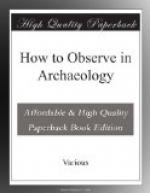The following are the languages and scripts which may be found in Palestinian Epigraphy.
Egyptian, in Hieroglyphics. Greek.
Babylonian Cuneiform. Latin.
Assyrian Cuneiform. Arabic,
in Cufic script.
Hebrew, in ancient script. Arabic,
in modern script.
Hebrew, in square character. Armenian
(in mosaic
Phoenician. pavements,
also graffiti
Moabite. in Church
of Holy
Aramaic. Sepulchre).
Tables of the chief alphabetic and numeral forms of the West Semitic scripts are given in Illustrations X & XI; for the Greek, see Illustration IV.
3. The traveller should have had practice in making measured drawings of buildings.
4. For some branches of work a good knowledge of Arabic is indispensable—not the miserable pidgin jargon usually spoken by Europeans, nor yet the highly complex literary language, which is unintelligible to the ordinary native, but the colloquial of the country, spoken grammatically and properly pronounced. Work done through dragomans is never entirely satisfactory, because it requires the unattainable condition that the dragoman should be as much a scientific student of anthropology and of archaeology as the traveller himself.
5. The student for whom these pages are written should not attempt any excavation, unless he has been trained under a practical excavator, and has learnt how work, which is essentially and inevitably destructive of evidence, can be made to yield profitable fruit. There is plenty of work that can be done on the surface of the ground without excavation.
[Illustrations X & XI: Table of West Semitic Alphabets & Numerals.]
II. Sites of Towns and Villages.
1. Nomenclature. The sites of ancient towns and villages are usually conspicuous in Palestine, and are recognized in the local nomenclature. They are denoted by the words tall, plural tulul, meaning ‘mound’, and khirbah, plural khirab meaning ‘ruin’. These words are commonly spelt in English tell and khirbet (less correctly khurbet) and we use these more familiar forms here. As a rule, though not invariably, the sense of these terms is distinguished. A tell is a site represented by a mound of stratified accumulation, the result of occupation extending over many centuries, and easily recognizable among natural hillocks by its regular shape, smooth sides, and flat top. A khirbet is a field of ruins in which there is little or no stratification. Nearly all the sites of the latter type are the remains of villages not older than the Byzantine or Roman period.




